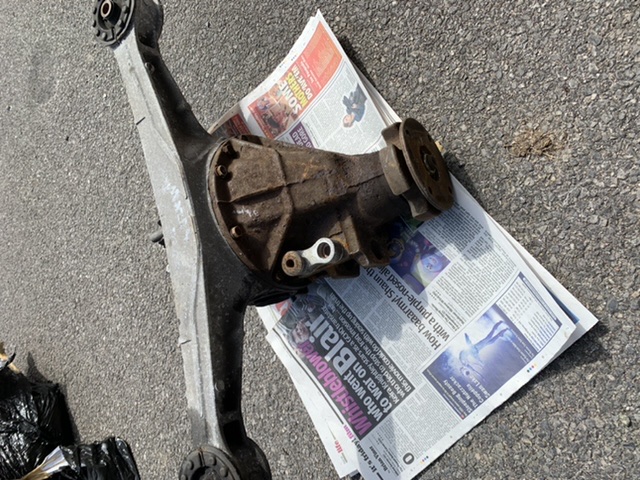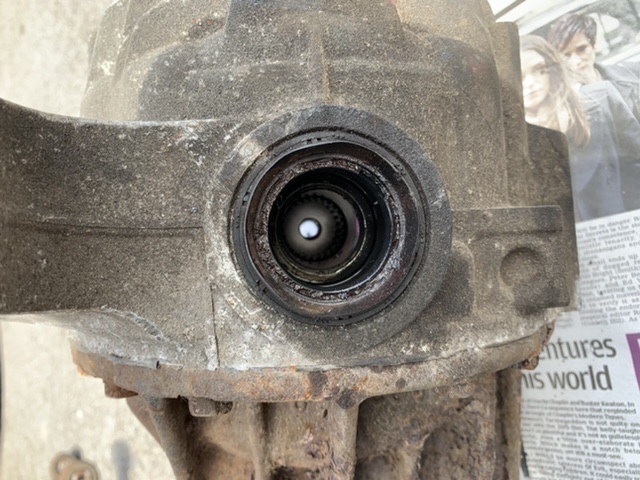Hi Folks. First time posting…
I just bought a Torsen type 2 LSD off an Ebay scrapper who didn’t know what it was… for pretty cheap…No idea of the mileage of the donor other than it looked like a pretty standard 1998 Mk2 1.8S. He drained the diff before posting and said it looked clear… That all I got. bit of a gamble I know!
What would you guys recommend I do to give it the once over once it goes into the car? Happy to take stuff to bits but don’t want to have to get it professionally put back together if I don’t have to. Clearly the outside will be tarted up (the front housing looks pretty rusted so guessing its been out of the car for a while) but are there any easy tell tales of a diff that’s needs some sort of TLC off the car? fingers crossed it is as good as the day it went in…Torsens are bulletproof right???
Any Torsen 2 advice would be gratefully received.
Cheers for the input.
James
“He drained the diff before posting and said it looked clear…”
What the oil?
I’ve drained a few diffs on my MX-5’s even after very few miles in-between oil changes, none have been clear😬
I’ll leave others to suggest what to look for before you fit it.
If it rotates smoothly, I’d replace the driveshaft seals, pop it in as it is with new oil and take a punt.
Yup. The oil was clear…guess that means no bits of metal! Fingers crossed.
Torsen Type 2s are pretty much bullet proof.
But, which ratio is it?
Aren’t all Mk2 Torsens 3.6, not 4.1 or .4.3 (Mk1)? Its always been a bit vague if any 5-speed Mk2 ever had a LSD.
Ummmm. Bit of a noob when it comes to ratios…guessing it is all about the acceleration? I need to find a good tutorial. Which is best for general wizzing round country roads in a very light mx5 based kit car? How can i tell which ratio it is?
Cheers.
James
The final drive ratio will basically affect acceleration, top speed and MPG. As most people rarely use high speeds for road use, a final drive that lowers the top speed will increase acceleration. This is because at 4,000rpm you will be doing a lower speed, therefore as the engine speeds up you will have to change gears more often, but it will mean that the engine is spinning at higher RPM for any given speed, thus increasing MPG. The car will also be noisier, as you will be doing higher revs at a set speed than you were before. However the upside is you will get to change gear more on country roads etc and accelerate quicker, but it is like changing the exhaust or intake for a noisier one - it depends on what you want from the car.
I am not able to tell you the technical details of which ratio will cause exactly what effect to your car. However if you check before you change it the revs at set speeds in each gear, you can then check again after you have changed it. If it doesn’t work for you - change it back… I don’t think it will change the speedo reading as I think that will pick up from elsewhere, but I did change the gearbox on an MG metro years ago and the speedo was incorrect and I had to change a plastic gear in the gearbox…
Brilliant. Thanks for that. Got some research to do on final drives to see what i would likely have in my standard 2005 1.8 icon and the diff which in is from a torsen 2 from a standard 1998 1.8 S.
Im hoping for acceleration and not top speed, sonim guessing the lower the ratio the better.
Anyone know what ratio diffs were in each car?
Thanks
James
I think you have done very well.
If my information is correct…
1.8 5MT NB ‘iS’ grade JTEKT/Zexel TORSEN® LSD (Type 2) (4.1 FD)
The Torsen type 2 with 3:6 ratio was fitted to the early SVT sport 2001 - 2.
For your purposes I would say 4:1 is ideal.
Boom! very pleased about that. lets hope the scrapper LSD is good. Now I can go faster in a straight line and round the corners…
Never driven and LSD before so hopefully don’t crash on the first corner!
J
What would the final drive be on my standard 1.8 icon 2005 open diff?
Cheers
J
4.100 if 5-speed, 3.9 if from a 6-speed.
I have a 4.3 T2 on my 96, so, in principle, faster 0-60, but lower top speed, than a 1995 with a 4.1 diff.
See:
https://www.flyinmiata.com/tech/gearing.php
Cool That sounds good so essential the final drive of both diffs is the same, this ones a slippy!
Cheers for that. glad its not going to make the car a little sluggish off the line.
No doubt I’ll update this post once it arrives from the scappy in a few days…keep your fingers crossed for me that it will be good.
Post in a few days peeps.
Cheers
James


Diff just arrived. It looks good, drive rotates smoothly. Definitely a torsen 2. Chuffed.
Is it worth flushing it with some sort of fluid before putting in the car? You never know how carful the scrapy was to not get any muck or dirt in there with the halfshafts off.
Next test is to try it with the half shafts in and see if they feel smooth too. Thats a job for some other weekend.
Any prep tips would be greatly appreciated.
James
Are you going to fit the diff itself (the cast iron part) to your own housing (aluminium part)? That’s what I would do as it saves removing the complete housing from your car. If doing that, you’ll be able to clean out the inside when it’s out of the housing if you want to.


No need to worry about not removing the diff. The rear subframe and control arms are off to the grit blaster soon! The powerframe is the basis of a MEV Exocet kit car lockdown project!
Wasnt going to split the diff casing for no other reason than i thought it was probably easier and less likely to get ruined if I went that route. What do you think?
As a guide, if you have the opportunity to change fluids and any seals when you have a piece like this easily accessible I would. However I am not familiar with the part so I do not know how easy it is, but this is a general rule. For example if you split the gearbox/engine, always change the clutch at the same time etc. Then you know that it is refreshed , especially as you just do not know the last time it was done and it will be more difficult to do later.
Hmmm. I don’t know much about the diff, millage of the car how much action it has had…I’m tempted to split the casing and take a peek inside. when you split the housing are there loads of fiddly bits and pieces that are going to fly apart or is it pretty easy to take a look around the workings without disassembling too much?
I’m guessing it will need a new gasket or seal when putting back together.
Cheers peeps.
It splits very easily, nothing will fly out, the diff assembly is fully contained in the cast iron part. There is no gasket, use silicone sealer on reassembly. Seems daft not to take a peak inside while you’re at that stage, then it’s up to you if you change the carrier as well or not.
Defo split then. Also it will mean I can get in and clean any gunk and look for any bashed bits. The carriers look decent on both diffs so may aswell leave the open diff unfettled as a spare.
Is it worth cleaning the internals with some fluid or spray whilst it is open?
J




